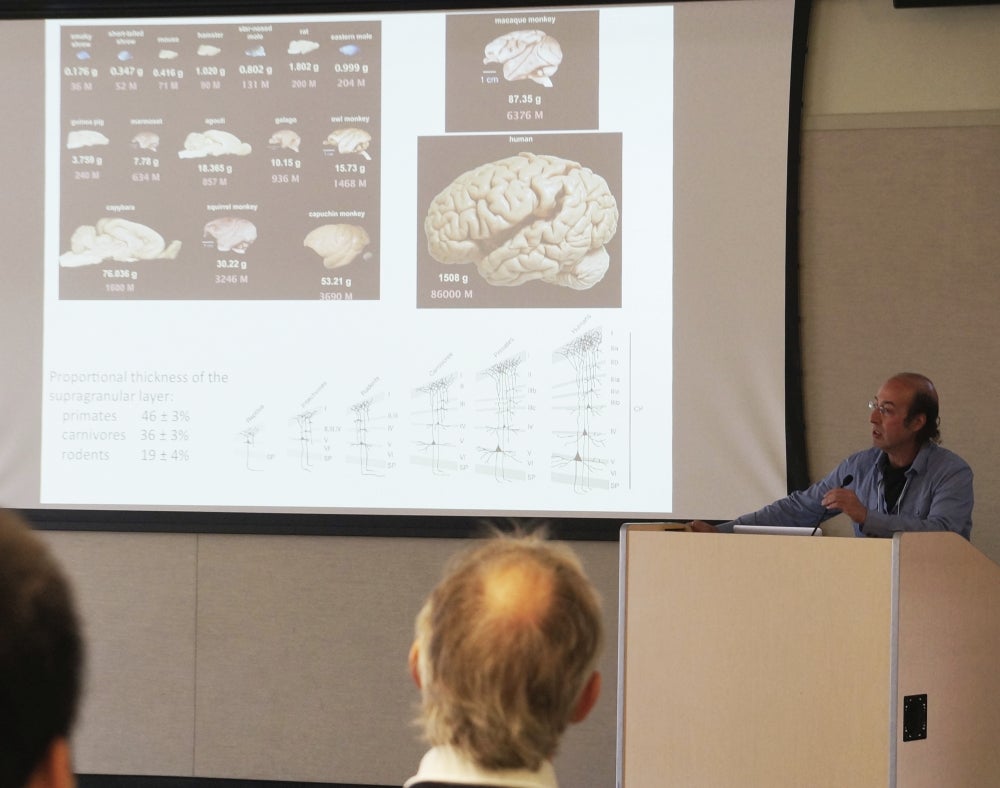Breakthroughs in Systems Neuroscience
Some of the most profound conditions affecting humans — from Alzheimer’s disease and autism to schizophrenia and bipolar disorder — are neurological in origin. Yet despite decades of research, the brain and its related diseases remain largely a mystery.
So said UC Santa Barbara’s Kenneth S. Kosik, speaking at a daylong conference exploring systems neuroscience, the study of how nerve cells behave when connected as neural networks.
Eight California scientists at the forefront of brain research met at UC Santa Barbara to present some of their latest findings. “The goal is not just to hear great science,” said Craig Montell, Duggan Professor of Molecular, Cellular and Development Biology and Neuroscience, “but also to highlight the fact that there’s a lot happening here on campus in neuroscience and to potentially foster collaborations.”
Montell organized “Molecular and Cellular Breakthroughs in Systems Neuroscience” with Kosik, the Harriman Professor of Neuroscience. The symposium was designed to showcase the kind of cutting-edge neuroscience research being conducted at UC Santa Barbara and at other research institutions around the state.
“UCSB has a very strong track record in engineering, physics, computer science and in biology, too, and putting all of these groups together allow us, I think, to be a very major — and, more importantly, unique — player in the neuroscience arena,” said Kosik, who is also co-director of the Neuroscience Research Institute.
Kosik’s areas of expertise include Alzheimer’s disease — both the causes of and treatments for — as well as the exploration of fundamental biological processes, particularly those related to the brain and its evolution. His presentation focused on the latter as he described the role of microRNAs in a portion of the brain called the outer subventricular zone, a unique evolutionary innovation in the primate brain. According to Kosik, the microRNAs he studies are a melding of molecular and anatomical information.
Montell’s research revolves around a central goal of neurobiology: defining the molecular and cellular mechanisms through which animals translate sensory input into behavioral outputs. Scientists in his lab uses fruit flies to investigate how animal behaviors are influenced by changes in temperature, light input, gustatory and olfactory cues and mechanical forces.
Montell’s presentation highlighted TRP channels, a class of cation channels that are critical for responding to sensory stimuli and for neuron activation. His lab is characterizing the roles of TRPs in regulating animal behaviors ranging from the effect of thermal sensation on feeding behaviors to olfactory avoidance.
Conference participant Ulrich Mueller, chair of the Department of Molecular and Cellular Neuroscience at The Scripps Research Institute in San Diego, discussed his work on the molecular mechanisms of auditory perception. His research team has cloned several components of the mechanotransduction machinery of hair cells, which converts sound stimuli into electrical signals. His lab also has identified numerous gene mutations that cause deafness and regulate the function of the auditory system.
“I was interested in hearing Mueller’s talk because it might be related to my work as well,” said Sarah Abdul-Wajid, an MCDB graduate student who has identified a mutant gene in sea squirts and frogs that is responsible for a life-threatening birth defect. “That was the number one draw but I was also interested in the other speakers as well.”
Additional conference participants were Don Cleveland of UC San Diego, Viviana Gradinaru of the California Institute of Technology, Diana Bautista of UC Berkeley and Lu Chen and Thomas Südhof of Stanford University.
In his presentation, Cleveland, a professor of neurosciences, outlined the painstaking development of an intricate process that can silence genes involved in neurodegenerative disorders such as amyotrophic lateral sclerosis and Huntington’s disease.
Gradinaru, an assistant professor of biology, has played an instrumental role in the early development and applications of optogenetics. As the term implies, this field combines techniques from optics and genetics to control and monitor the activities of individual neurons in living tissue. She discussed the complicated techniques her research team developed to create transparent tissue in mice.
Bautista, an associate professor of cell and developmental biology, shared her lab’s efforts to understand the molecular mechanisms underlying the sensations of itch, touch and pain.
Stanford University School of Medicine’s Chen, an associate professor of neurosurgery and of psychiatry and behavioral sciences, and Nobel laureate Südhof, professor of molecular and cellular physiology, study aspects of the brain’s synapses, the junctions between two nerve cells. Synapses allow electrical or chemical signals to pass from one neuron to another. Südhof shared the 2013 Nobel Prize in Physiology or Medicine for “the discovery of machinery regulating vesicle traffic, a major transport system in our cells.”
The breadth of symposium speakers illustrates the depth of ongoing research dedicated to understanding the human brain. This is particularly significant given the mandate of the federal BRAIN (Brain Research through Advancing Innovative Neurotechnologies) Initiative announced by President Obama in 2013, which challenges scientists to map the human brain in its entirety.
“The brain almost seems like the last frontier in some ways,” Kosik said. “The challenges are great but the tools are coming online now to make inroads.”
The symposium was funded by alumnus Gus Gurley and by the Kavli Foundation.






